CD of the Month:
Renée Fleming: Haunted Heart
Other Reviews:
DVD -- Montserrat Caballé: Bel Canto
DVD -- Caballé: Beyond Music
CD -- Leonard Bernstein: Peter Pan
CD -- John Browne: Music From The Eton Choirbook • The Tallis Scholars
CD -- Lura: Di Korpu Ku Alma
CD -- Gustav Mahler: Symphony No. 8 In E Flat • Sir Simon Rattle, City Of
Birmingham Symphony Orchestra
CD -- Terry Evans: Fire In The Feeling
CD/SACD/DVD-A -- Johannes Brahms: Symphony No. 1 in C minor • Marin Alsop,
London Philharmonic Orchestra
CD -- Mozart Piano Works • Richard Goode

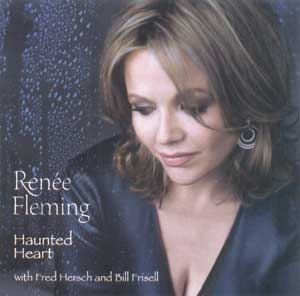 |
HAUNTING DIVAS
RENéE FLEMING: HAUNTED HEARTDECCA B0004406-02
|
|
0 |
5 |
|
Performance |
 |
|
Sonics |
 |
|
|
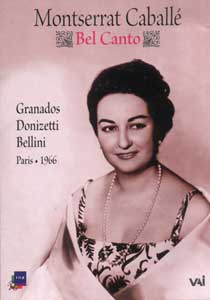 |
| MONTSERRAT CABALLé: BEL CANTO
VAI
DVD 4308
|
|
0 |
5 |
|
Performance |
 |
|
Sonics |
 |
|
|
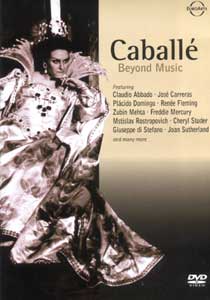 |
| CABALLé: BEYOND MUSIC
EUROARTS DVD
2053197
|
|
0 |
5 |
|
Performance |
 |
|
Sonics |
 |
|
“Guess who this jazz singer is?” I yelled to the spouse ensconced on the
floor above me.
“I don't know, but she sure is good,” responded said spouse with a tone that
suggested preoccupation with other matters.
All changed when I yelled back that the singer was opera diva Renée Fleming.
Suddenly it sounded like the Charge of the Light Brigade, with spouse and
dog competing to see who could race down the stairs fastest so they could
get a better listen.
“No, it can't be!” exclaimed he. “It doesn't sound like her at all.”
It's true. It doesn't. In a chameleon-like act of vocal transformation that
trumps both Anne Sophie Von Otter's collaboration with Elvis Costello and
Eileen Farrell's classic blues, Fleming unveils a totally unrecognizable,
captivatingly earthy delivery that sounds nothing like a diva's.
For the most part pitching her voice an octave lower than she does in opera
and recital, Fleming's Haunted Heart unveils the voice she developed during
her two years performing Sunday night gigs with a trio while studying at the
Crane School of Music. As she neared graduation, she even received an
invitation to travel to New York and tour with tenor saxophonist Jean-Baptiste
“Illinois” Jacquet.
Instead Fleming headed to the Eastman School of Music. Finding opportunities
for musical moonlighting limited, she chose the path that has crowned her an
operatic goddess of sorts.
Fleming's voice on Haunted Heart suggests influences as diverse as Joni
Mitchell, Barbra Streisand, and assorted black divas. This is not to say
that she sounds artificial (or, as in the case of her Broadway collaboration
with baritone Bryn Terfel, frightfully over the top). Hers is a genuine,
beautiful voice, seamlessly produced without hint of operatic airs that
vocally and stylistically mesmerizes in tunes as different as Joni
Mitchell's soul-tugging “River” and Fred Hersch's gorgeous “Haunted Heart.”
Hersch deserves more than his ten digits of credit. Fleming first
encountered the music of this brilliant, multiple Grammy-nominated HIV
activist in the late ‘90s. She later performed with him in a benefit for
Classical Action. His suave piano improvisations, matched by the guitar
virtuosity of Bill Frissell, help raise Fleming to heights of sophistication
sometimes absent from her other endeavors. The rare meeting of genres in
their melding of Alban Berg's 12-tone Wozzeck with Lionel Hampton's “the
Midnight Sun” is a trip.
Yes, there are a few question marks. Gustav Mahler's “Liebst du um Schönheit,”
sparingly accompanied by Frissell, sounds discomforting sung in a timbre
usually associated with smoky dives. And when Emile Paladilhe's “Psyché,”
intoned in the higher voice Fleming uses in recital, follows suit in
anything but idiomatic style, memories of Barbra Streisand crooning Gabriel
Fauré's “Après un reve” as though she were Grandma Goldberg doing the wash
flashes warning signs. Stephen Foster's “Hard Times Come Again No More”
lacks simplicity, and there is a sameness to Fleming's unquestionably
nuanced delivery. But in the end, so what? The rapturous beauty of
Lennon/McCartney's “In My Life,” Stevie Wonder's “My Cherie Amour,” and
Jimmy Webb's “The Moon's A Harsh Mistress,” let alone Hersch's “Haunted
Heart,” render this disc a triumph.
--
Although Spanish Diva Montserrat Caballé once descended from the operatic
stage to collaborate with Freddy Mercury in the beyond camp Barcelona, she
by and large stuck to realms she was sure to conquer. One of those was the
Salle Pleyel, where she made her Paris début on October 15, 1966. Captured
by VAI on the black & white DVD Montserrat Caballé: Bel Canto, the
performance shows Caballé in glorious voice albeit a bit reserved
interpretively.
After a selection from Granados' Goyescas, Caballé launches into Donizetti's
“Vivi ingrato” from Roberto Devereux with an amalgam of passion and
exquisitely floated pianissimos surpassed only by Beverly Sills a few years
later. Her “Al dolce guidami” from Anna Bolena, with which she had conquered
New York and the world the year before, remains incomparable save when set
aside Caballé's other live versions that evidence even greater lingering
over mesmerizing gossamer highs. And if no one could do the final scene of
Bellini's Il Pirata like Callas, Caballé's version nonetheless shows the
voice remarkably free, her physical presence unflinchingly dramatic and
convincing.
More and less is revealed about the singer in EuroArts' Caballé: Beyond
Music. The documentary intersperses clips of live performances with
interviews with Caballé, her family, and a host of artists including Renée
Fleming, Joan Sutherland, and Mstislav Rostropovich.
The more comes in the revealing tidbits. There's a hilarious section where
Freddie Mercury confesses that he initially thought he would need to hold
back so that he wouldn't upstage the Diva, followed by their actual
performance in which he must strive to make himself even bigger than usual
to match Caballé's ecstatic extension of arms and voice. Elsewhere, Caballé
comes off oh so sweet, just as she is in real life, with occasional
references to her artistic temperament (fierce competitiveness, frequent
last minute cancellations, and the occasional broken object when she
couldn't have her way).
As with many documentaries of this nature, it's maddening to discover
yourself totally involved with the singing, only to have it arrested
midstream to allow for commentary. Some of the accolades are gratuitous,
kissing the Diva's hand rather than revealing what she's got under her
sleeve. But what insights and singing survive intact are too good to miss.
Malcolm Boyd, who marched with Martin Luther King before coming out in
print, once told me of a night that he and countless other devotees attended
a Caballé performance. The Diva was so sensational that they refused to
leave the theater, shouting “Diva, Diva, Diva” even after the house lights
were turned on and the curtain closed. Finally, with only 50 screaming opera
queens left in the house, Caballé re-emerged to welcome them to the stage
and say hello. These DVDs help reveal the magic that had us all worshipping
at her feet.

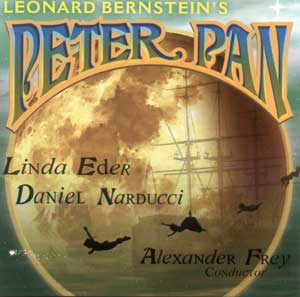 |
| LEONARD BERNSTEIN: PETER PAN
KOCH
CLASSICS 0 99923 75962 1
|
|
0 |
5 |
|
Performance |
 |
|
Sonics |
 |
|
Leonard Bernstein's Peter Pan? Beyond the 2003 movie with Jeremy Sumpter
and the 1953 animated version from Disney, thoughts turn to Mary Martin
flying through the air to Jerome Robbins' choreography in the 1954 Broadway
musical and several televised follow-ups. But Martin's “I'm Flying” and
“I'll Never Grow Up” were created by Carolyn Leigh and Moose Charlap; the
pre-Michael Jackson “Neverland” and other hits were supplied by Betty Comden
and Adolph Green. Where does Leonard Bernstein fit in?
As it turns out, several years before Martin flew her way to a Tony Award
and Cyril Ritchard wielded his sword, producer Peter Lawrence asked Leonard
Bernstein to write the score for a 1950 Broadway musical based on Sir J.M
Barrie's character Peter Pan. Lenny, energized by the success of On the
Town, composed over an hour of music, mostly consisting of atmospheric
orchestral interludes punctuated by songs for Peter, Captain Hook and
chorus. (Composer Mark Blitzstein was enlisted to help Bernstein, but he
accomplished perhaps even less than he did with his subsequent Met operatic
commission, the unfinished Sacco and Vanzetti).
When it was discovered that the leads (Jean Arthur as Peter Pan and Boris
Karloff as Captain Hook) had limited vocal abilities, the production morphed
into a play with songs thrown in. Only Bernstein's “Who Am I?,” “Pirate's
Song,” “Plank Round,” “Build My House” and “Peter Peter” were retained, with
new instrumental underscoring by Alec Wilder. Bernstein's “Captain Hook
Soliloquy,” “Dream With Me” and orchestral interludes lay unheard and
basically lost until 1997, when Alexander Frey began the task of
reconstructing the original version.
Almost a decade later, with support from Susan DelGiorno, General Manager of
Koch International Classics, this belated début recording from Koch lets us
hear what we've missed. All of Bernstein's songs and orchestral interludes
are present. In addition, his longtime collaborator Sid Ramin, provides a
new orchestration for “Dream with Me,” with other orchestrations from Fry
and Garth Edwin Sunderland complementing originals by Trude Rittman and
Hershy Kay,
Bernstein's Peter Pan is an unmitigated delight. Lenny took naturally to the
trouser role of Peter, creating an enchanted fantasy world in which even
Captain Hook – the meanest of the mean and lowest of the low – lightens the
heart as he intones “Eat Blood! Drink Blood! Dream Blood! Think Blood!”
Musical interludes echo and build upon each other, creating a closed
universe where harm transforms to charm, and fairy tales become inseparable
from reality. Think the smile in Mary Martin's voice in instrumental form.
The star of the recording is the incomparable Linda Eder as Peter. Eder's
ability to sound innocent and sweet without becoming cloying is as wondrous
as her clear enunciation on the highest notes. You must hear this
performance: Eder's versions of “Build my House and “Dream with Me” are
destined to become classics, as memorable as anything Martin or Merman ever
recorded. Baritone Daniel Narducci does a fine if occasionally shaky job as
Captain Cook, and Frey's Amber Chamber of Orchestra of Prague sounds as
convincing as any Broadway pick-up band. With a delectable bonus in the form
of Eder and Michael Shawn-Lewis' duet on Bernstein's “Spring Will Come
Again,” originally intended for Thornton Wilder's The Skin of Our Teeth,
Bernstein's Peter Pan is a joy.

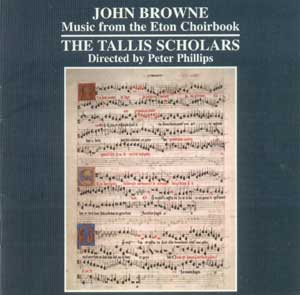 |
| JOHN BROWNE: MUSIC FROM THE ETON
CHOIRBOOK THE TALLIS SCHOLARS
GIMELL CDGIM236
|
|
0 |
5 |
|
Performance |
 |
|
Sonics |
 |
|
Millions of John Brownes have come and gone, but only one wrote music
this mystical and refined. The John Browne whose sacred compositions helped
usher in the 16th century Renaissance made music history by composing the
first work in eight-part polyphony (eight voices moving independently).
Considered so remarkable that it was chosen to open the Eton Choirbook,
Browne's O Maria salvatoris is only one of eight of his compositions to
survive in complete form.
Browne's skill extends far beyond an ability to write for multiple voices.
His exquisite interplay of vocal lines, which swell from two up to eight
depending upon emotional content, remains unequalled in the history of
Renaissance composition. So too does the sheer length and breadth of his
melodies; only 19th century operatic composer Vincenzo Bellini managed to
enrapture listeners with melodies that took nearly as long to unfold.
Most important, the music is gorgeous, far more expressive and inventive
than most Renaissance fare. Browne's Stabat iuxta for three tenors and three
basses conveys a wealth of emotion within a limited octave range. After a
single voice intones “Vidit caput inclinatum” (Mary saw Christ's head bowed
low), all six male vocalists sing “Totum corpus cruentatum” (all his body
stained in blood) full out to underscore the depth of Mary's anguish while
witnessing Christ's crucifixion. The writing is so expressive that even born
again pagans can sense the pain and faith at the heart of Christianity.
Over three decades after Peter Phillips founded The Tallis Scholars, his a
cappella ensemble continues to produce music of extraordinary purity. The
high sopranos are positively angelic, the tenors and altos (both male and
female) lovely, the basses excellent (if in rare cases aggressive). When
everyone opens up in the final Amen of “O regina mundi clara,” the effect is
thrilling. The Tallis Scholars' delight in singing music of such exalted
expression has produced priceless performances that can transport listeners
to another dimension.

 |
| LURA: DI KORPU KU ALMA
LUSAFRICA
|
|
0 |
5 |
|
Performance |
 |
|
Sonics |
 |
|
Thanks to the support of the great Cesaria Evora, who invited her to
perform as her opening act, Lura's captivating vocalism and uplifting spirit
have brought a new, enthusiastic audience to its feet. Both women hail from
Cape Verde, a poor archipelago 300 miles west of Dakar, Senegal whose
African musical traditions were mostly suppressed by the Church and
Portugal's colonial government prior to achieving independence in 1975 (the
year of Lura's birth).
Lura's latest CD, whose title translates as Of Body and Soul, comes
beautifully packaged in a thick, colorful album complete with song
translations. It also includes a bonus DVD featuring Lura's 2004 opening act
concert for Evora at Paris' Grand Rex. Short video singles shot in Cape
Verde and Cuba, an autobiographical portrait, and assorted fluff complete
the program. All reveal an alluring artist whose earthy contralto and
sensual warmth prove irresistible.
After first working as a swimming teacher and dancer, Lura began singing at
17, recruited by the singer Juke to perform a duet in the commercial Zouk
style of African music popular in Portugal where Lura was born and raised.
Her early commercial efforts, created with a European audience in mind,
included her own positively addictive song “Nha Vida.” First featured on the
Red Hot + Lisbon compilation for the campaign against AIDS, “Nha Vida”
reappears on this album. While it may reflect an assimilated style of
African music that attracts white audiences at the expense of authenticity,
it allows her uplifting spirit full reign.
Lura has since become one of the first vocalists of her generation to
re-explore Cape Verde's African musical heritage of funana (considered too
erotic for the Christian colonialists) and batuku. The latter style
developed when a dozen or more women beat a batuku rhythm on folded stacks
of clothes held by their knees as a lead singer improvised poetry lampooning
or critiquing community happenings while performing an extremely sensual
dance called torno.
Some of the most delightful batuku-style songs on the disc, the fun “Na Ri
Na” and catchy “Vazulina” (about abusing Vaseline while straightening hair
with hot irons) were written by the young Orlando Pantera, who
revolutionized the batuku style before dying in 2001. The fabulous “So Um
Cartinha” by Lura and Fernando Andrade Lopes pokes fun at the Cape Verdean
custom of asking friends who are visiting Lisbon to take back “a little
letter,” then presenting them with a fully packed trunk. Lura's own “Tem Um
Hora Pa Tude.” (“There is a Time for Everything”) was written at the urging
of Evora. All feature delicious, danceable rhythms and Lura's engaging
warmth.
Accompaniment, limited to five acoustic musicians on the DVD, is unusually
spare and sophisticated. Rather than driving the point home, Lura and her
understated backup luxuriate in the sensuality and joy that fuel Cape
Verde's musical renaissance.

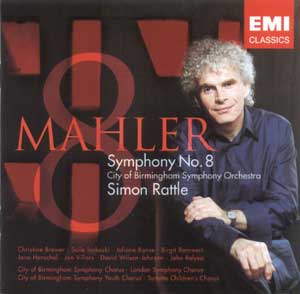 |
| GUSTAV MAHLER: SYMPHONY NO. 8 IN E
FLAT SIR SIMON RATTLE, CITY OF BIRMINGHAM SYMPHONY ORCHESTRA
EMI CLASSICS 7243 5 57945 2
|
|
0 |
5 |
|
Performance |
 |
|
Sonics |
 |
|
“I have just finished my Eighth,” Gustav Mahler wrote in a 1906 letter to
his conductor friend Willem Mengelberg. “ It is the greatest thing I have
yet done… Try to imagine the whole universe beginning to ring and resound.
These are no longer human voices, but planets and suns revolving.”
Mahler's most spiritually uplifting symphony requires no less than eight
stellar soloists, four choruses (two of them children's choruses), and an
orchestra of 120 players to realize his idea of celestial forces. Dubbed
“Symphony of a Thousand” by the manager of the concert agency who arranged
its 1910 premiere, the much-heralded first performance literally assembled
close to 1000 musicians before an audience that included members of Europe's
royalty and artistic elite.
The two-part vocal Symphony No. 8 in E Flat opens with the glorious hymn
Veni, creator spiritus; the huge second part is loosely based on the final
scene of Goethe's Faust. The work's final sections begin as an initially
soft orchestral interlude builds into music so heavenly that only Mahler
could write it. As soloists and choruses join in, the music builds to a
tremendous climax. With everyone and their mother singing, playing and
pounding at full volume, the conclusion counts as one of the most stirring
statements of faith in the classical repertoire.
The latest recording of Mahler's Eighth joins a field that has for a long
time been dominated by Sir Georg Solti's 1971 outing with the Chicago
Symphony Orchestra, Vienna choruses, and the top international soloists of
the day. Recorded live in 2004, the performance by Sir Simon Rattle and the
City of Birmingham Symphony Orchestra (EMI) sweeps the field on both sonic
and interpretive grounds. Rattle's trio of soprano soloists -- the glorious
Christine Brewer, radiant Soile Isokoski, and heavenly Juliane Banse -- at
least equals Solti's soprano triumvirate, and the Birmingham and Toronto
choruses sing wonderfully.
Most important, Rattle understands the tremendous sweep of Mahler's music.
From Part Two's hushed orchestral opening which depicts a natural setting
filled with holy beings, to the stunning conclusion where Mater Gloriosa's
call to rise to higher spheres summons forth music that literally feels like
the opening of heaven's gates, Rattle and his forces make an awe-inspiring
statement of faith. If writing such a breathtaking celestial invocation
could not in the end save Mahler, a much-persecuted Jew whose marriage and
health were literally crumbling at the time, his music nonetheless survives
as an indelible example of the human potential for transcendence.

|
 |
| TERRY EVANS: FIRE IN THE FEELING
VALLEY ENTERTAINMENT
VLT-15200
|
|
0 |
5 |
|
Performance |
 |
|
Sonics |
 |
|
In his first CD release since 2001's Mississippi Magic, veteran
Mississippi bluesman Terry Evans returns with heart-tugging voice and
musical soul intact. This superb artist, whose Audioquest/JVC-XRCD Puttin'
It Down release counts among my favorites, sets the disc's tone with “Uphill
Climb (To the Bottom).” Rather than creating another one of those “how
terrible life is” laments, Evans looks life squarely in the eye and
emphasizes the importance of positive thinking. Viva la difference!
The most heart-touching song on the disc is Ry Cooder's “My Baby Joined the
Army.” The moving pathos of Terry's rendition is alone worth the price of
the album.
Evans' relationship with Ry dates back to 1976, when Terry and Bobby King
began to provide background voices for several of Ry's albums. Terry also
toured with Ry, and sang lead vocal on “Down in Mississippi,” a song from
the Crossroads movie soundtrack that variously features Ry and Terry singing
the title song. (Evans has also recorded with Joan Armatrading, John Lee
Hooker, Boz Scaggs, Maria Muldaur, and Pops Staples for starters).
The blues being what they are, Evans performs the inevitable seductive
paeans to the female sex. “Let's Get Gone,” “Discover Me,” “Turn on Your
Lovelight,” and the fabulous “I Got a Pony (She Likes to Ride)” are among
the titles devoted to warming the love nest. The latter title, by rhythm
guitarist John Rhys-Eddins (who shares duties on the instrument with Terry)
and Bob Berne provides the answer to Mae West's classic “Is that a pistol in
your pocket” query.
Terry Evans' “I'll Be Your Shelter (In the time of Storm)” serves as a
perfect companion to James Taylor's classic “You Need a Friend.” Even when
Evans complains about the “Racket in the Room” from a neighbor's hip-hop
party, he's got a smile on the voice. Nonetheless, this is not a disc based
on denial, as the superb “Walkin' Chains” by the album's percussionist Phil
Bloch, Tony Gilkyson, and Terry Evans reminds us what country and state
we're in. With expert backup from veteran musicians, this counts as one of
the most gratifying discs I've heard this year.

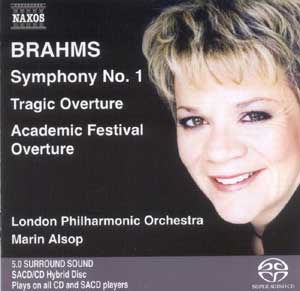 |
| JOHANNES BRAHMS: SYMPHONY NO. 1 IN C
MINOR MARIN ALSOP, LONDON PHILHARMONIC ORCHESTRA • NAXOS 6.110077 (SACD)/5.110077(DVD-A),
7.110077 (CD)DEVA PREMAL: DAKSHIMA
NARADA
724386029126
|
|
0 |
5 |
|
Performance |
 |
|
Sonics |
 |
|
Conductor Marin Alsop's superb recordings of Barber, Bernstein and other
modern masters have created expectations that her main focus will remain 20th
century repertoire. It therefore comes as somewhat of a surprise – a welcome
one to be sure – to discover her turning to Brahms, whom she calls "a composer
very close to my heart.”
“I remember hearing a recording of the Brahms B flat string sextet when I was
12 years old,” write Alsop, “and becoming absolutely transfixed by the
experience. For the first time in my life I felt deeply moved by music and I
understood the extreme emotional impact that music could have on us. As I
immersed myself in his compositions, I could relate to and appreciate his
struggles and life conflicts. To hear his majestic First Symphony, which he
laboured over for decades, is to be changed! Recording his music and sharing
performances and ideas about him and his music with audiences is a dream come
true for me."
Naxos' faith in Alsop shows not only in their decision to issue the
performance in all three digital formats, but to also lavish great care on the
DSD recording. Brahms' romantic scoring includes so much for instruments
playing low and mid frequencies that this issue can serve as an excellent test
for a system's ability to reproduce midrange and bass.
I initially used the SACD and DVD-A issues to evaluate the Muse Universal
Player, whose review will soon appear on this website. My first impression was
that Naxos' engineers had done a mediocre job; so much of the midrange was
muddied. Then, after Mike Farnsworth of Talon Audio performed the 2005 upgrade
to my Talon Khorus X speakers and I discovered my speakers conveying far more
lower midrange and bass information than before, I consulted with him about
speaker placement. Mike suggested that I move my babies 6” farther out in the
room to conquer a suspected room node. He was correct. The muddiness I had
initially attributed to recording technique was in fact caused by less than
optimal speaker placement. Naxos has issued an excellent recording with a
convincing midway hall perspective, natural symphonic resonance, and
significant range and depth.
The performance is excellent. Playing all of Brahms' repeats (which the
composer felt were not necessary to include once listeners had a good sense of
his thematic progression), Alsop's timings for the second, third and fourth
movements are virtually the same as Von Karajan's classic performance with the
Berlin Philharmonic. Alsop's first movement may be over two minutes longer,
but there is never a sense of lag.
Most important, Alsop's tempos always sound on the mark. The London
Philharmonic plays with great vigor, avoiding the Germanic heaviness heard on
several classic recordings. Von Karajan may be able to wring more heartfelt
tone and poetic nuance from his forces -- the beginning of the Second movement
is a case in point – but both conductors evidence loving sympathy for Brahms'
melodic line.
Naxos' sonics stand out for their huge dynamic range and ability to
realistically convey percussive weight. Paired with Brahms Tragic Overture and
Academic Festival Overture, this 5.0 surround sound high-resolution format
disc is a clear audiophile first choice.

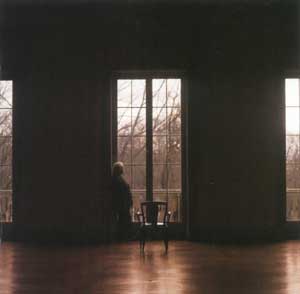 |
| MOZART PIANO WORKS
RICHARD GOODE
NONESUCH 79831-2
|
|
0 |
5 |
|
Performance |
 |
|
Sonics |
 |
|
“Too easy for children, too hard for adults,” said pianist Artur Schnabel of
Mozart's piano concertos earlier in the 20th century. While the works have
become widely known since then, and are generally considered, along with
Mozart's later operas, superior to his symphonies, many of his piano sonatas
and smaller pieces want for performances.
Richard Goode is out to change that. As evidenced from his superb Mozart Piano
Concerto recordings for Nonesuch, Goode has the feel of Mozart in his hands.
Every note has an inevitability about it, the phrases voiced with a grace that
bespeaks awareness that this music was written for instruments far lighter
voiced than today's modern piano. If romantic music has a feeling of
horizontal ebb and flow and emotional surges, Mozart's classicism is invested
with the vertical clarity that Goode brings to his playing. There is masterly
clarity to his touch, gracing every note with awareness. The divine perfection
that is Mozart at his best is everywhere in evidence.
The disc begins with the familiar Sonata in A minor, K. 310. Written in Paris
when Mozart was 22 the work conveys the tragedy of the death of Mozart's
mother at the beginning of the summer. After the furious pace of this work,
the March in C major, Mozart's piano reduction of a composition originally
intended for orchestra, provides a light, energetic diversion. The short
Courante in E flat major, K. 399 and Gigue in G major, K. 574 also whiz by
before Goode presents the exquisite sadness of the Rondo in A minor, K. 511.
Unless you know Mozart's music extremely well, Nonesuch's decision to maintain
the same length pauses between sonata movements and the shorter works
sandwiched between them lands you in “no particular work” land. Without the
booklet, one might not realize that the one-movement Rondo gives was to the
miraculous Sonata in F major, K. 533/494. The first movement bubbles over in
constant delight, while the middle movement andante speaks with poignancy. The
conclusion, written two years earlier (hence the mixed Köchel numbers), makes
great use of the keyboard's high register.
The Sonata in F major is irresistible. As elsewhere on the disc, Goode's
playing is so self-contained and poised that those who treat Mozart as
background music may miss the wealth of invention and nuance at the heart of
these works. The more attention you devote to the playing, the more you can
appreciate Mozart's genius. Sound quality is ideal, with natural piano
resonance.
- Jason Victor Serinus
-